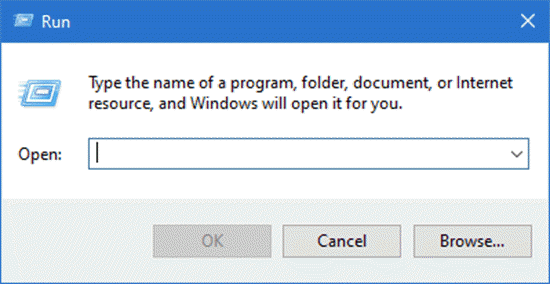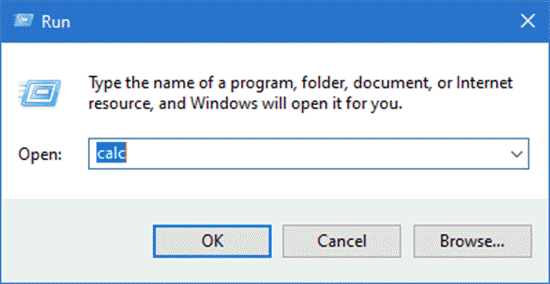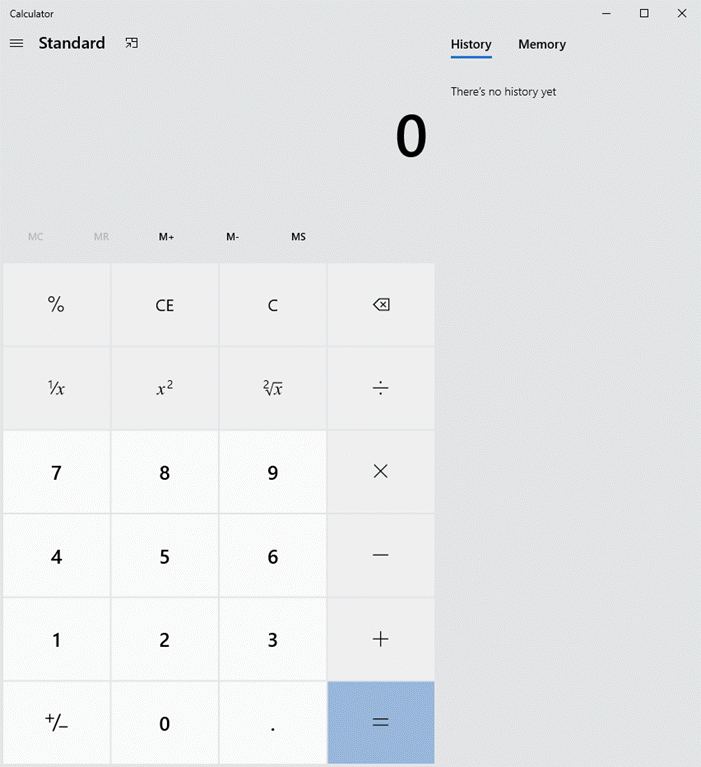When used correctly, Windows 10’s run command can be an extremely powerful feature. It can be used to open files and folders, launch programs, and access internet resources in Windows. The fastest and easiest way to open the Run command in all versions of Windows is to use the Keyboard shortcut Windows + R.
For Windows 10 right-click on the Start menu and select Run.

The Run command is launched.

We will use the calc command to open the calculator as an example.

The Calculator app is launched.

Listed below is a huge list of Run Commands you can use.
| RUN COMMAND | TASK NAME |
| colorcpl.exe | To open color management |
| azman.msc | To open authorization manager |
| certmgr.msc | To open certificate manager |
| chkdsk | To check disk state and functioning |
| cmd | To open command prompt |
| compmgmt.msc | To open computer management |
| control | To open control panel |
| control access.cpl | To open ease of access |
| control color | To open color and appearance |
| control folders | To open folder options |
| control fonts | To set fonts from control panel |
| control keyboard | To open keyboard properties |
| control mouse | To open mouse properties |
| control netconnections | To open network connections |
| control printers | To open devices and printers |
| control schedtasks | To open Task scheduler |
| control userpasswords2 | To open User accounts |
| control wuaucpl.cpl | To open windows update menu |
| credwiz | To open backup and restore menu |
| dcomcnfg | To open Component service |
| desk.cpl | To open Desktop resolution |
| devmgmt.msc | To open Device manager |
| dfrgui | To optimize drives |
| dialer | To open phone dialer |
| diskmgmt.msc | To open disk manager |
| diskpart | To open Disk partition utility in cmd |
| dxdiag | To open Directx diagnostics |
| eventvwr.msc | To open event viewer |
| firewall.cpl | To open firewall menu |
| fsmgmt.msc | To open shared folders menu |
| gpedit.msc | To open local group policy editor |
| inetcpl.cpl | To open internet options |
| ipconfig | To see ip address in cmd |
| iscsicpl | To open iscsi properties |
| logoff | To logoff current user |
| lpksetup | To install or uninstall display drivers |
| magnify | To open magnifier |
| mmsys.cpl | To open sound manager |
| msconfig | To open system configuration |
| msdt | To open microsoft support diagnostics |
| msinfo32 | To open system information |
| mspaint | To open paint |
| mstsc | To open remote desktop connection |
| ncpa.cpl | To open network connection menu |
| netplwiz | To open user accounts |
| notepad | To open notepad |
| osk | To open on screen keyboard |
| perfmon.msc | To open performance monitor |
| powercfg.cpl | To open power options |
| regedit | To open registry editor |
| rsop.msc | To open resultant set of policy |
| secpol.msc | To open Local security policy |
| services.msc | To open service manager |
| shrpubw | To open shared folder wizard |
| sigverif | To open file signature verification |
| slui | To activate windows with a product key |
| sndvol | To open volume mixer |
| sysdm.cpl | To open system properties |
| syskey | To securing windows account database |
| system.ini | To open system app support file in notepad |
| taskmgr | To open task manager |
| telephon.cpl | To open Location manager |
| telnet | To open telnet client |
| timedate.cpl | To open date and time manager |
| tpmInit | TPM security manager |
| verifier | To open driver verifier manager |
| wf.msc | To open windows firewall and advanced security |
| winver | To see windows version |
| wmimgmt.msc | To open WMI console |
| write | To open default text editor |
| wusa | To open windows update standalone manager |
